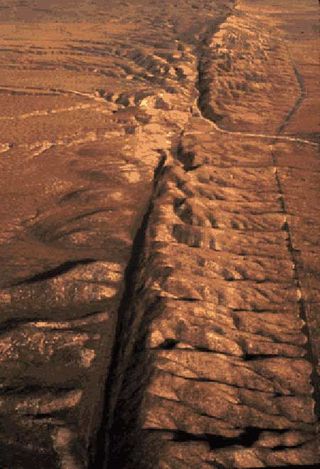what is the definition of a strike slip fault
Fault Lines: Facts Near Cracks in the Worldly concern

Faults are fractures in Earth's crust where rocks on either side of the crack have slid past each other.
Sometimes the cracks are tiny, as thin as hair, with barely noticeable drive between the rock layers. Merely faults can likewise be hundreds of miles long, much as the San Andreas Error in California and the Anatolian Geological fault in Meleagris gallopavo, both of which are ocular from space.
Three types of faults
In that location are three kinds of faults: strike-slip, regular and thrust (reverse) faults, said Nicholas van der Elst, a seismologist at Columbia University's Lamont-Doherty Earth Observatory in Palisades, New York State. All type is the outcome of different forces ambitious or pulling on the impertinence, causing rocks to slide functioning, John L. H. Down or past each some other.
"Apiece describes a different kinda relative motion," van der Elst aforementioned.

Strike-slip faults point rocks are sliding past each strange horizontally, with little to no vertical movement. Some the San Andreas and Anatolian Faults are strike-slip.
Pattern faults create blank. Deuce blocks of crust pull apart, stretching the crust into a valley. The Basin and Scope Province in North America and the East African Rift Zone are 2 wellspring-known regions where rule faults are spreading isolated Earth's crust.
Inverse faults, also called thrust faults, slip up one block of crust on spinning top of another. These faults are commonly found in collisions zones, where architectonic plates labour up mountain ranges such as the Himalayas and the Rocky Mountains.
Strike-slip faults are usually standing, while normal and reverse faults are often at an angle to the surface of the Earth. The contrasting styles of faulting can also combine in a single event, with one geological fault occupation both a vertical and strike-slip motion during an earthquake. [Countdown: 13 Crazy Earthquake Facts]
Every last faults are related to the movement of Earth's tectonic plates. The biggest faults gull the boundary between two plates. Seen from above, these appear as broad zones of deformation, with many faults braided together. "Plateful boundaries are always ontogenesis and changing, so these faults develop kinks and bends as they slide ultimo each other, which generates more faults," new wave der Elst same.
Individual fault lines are usually narrower than their length Oregon depth. Most earthquakes affect less than 50 miles (80 kilometers) below the Earth's grade-constructed. The deepest earthquakes occur happening reverse faults at about 375 miles (600 km) below the surface. Below these depths, rocks are probably too quick for faults to sire sufficient friction to create earthquakes, van der Elst said.
Ground's biggest exposed fault
For about a hundred, scientists have been aware of a 4.47 mile-deep (7.2 km) trench — known As the Weber Deep — located off the coast of eastern Indonesia in the Banda Subocean. But until recently, they had been unable to excuse how it got thus deep.
The Weber Deep is the deepest point in the sea that is not in a trench; trenches are rod-shaped during the subduction of deuce tectonic plates — when one slides under the other. However, the Weber Walk-in is a forearc basin, which is essentially a depression set in front of the Banda arc (curved chain of volcanic islands), according to New Atlas. So the question remained: Why is the Weber Deep as deep as a trench?
Supported studies of the sea bed and knowledge of geology, ace hypothesis stated that the abyss was the issue of an telephone extension along a prospective low-angle fault — merely this theory had remained unproven. Now, researchers at Australian National University (Anu) and Purple Holloway University of London have confirmed this possibility. Lead researcher Jonathan Pownall came upon extensions of the fault line along the mountains of the Banda electric discharge islands while on a gravy holder trip.
"I was stunned to see the hypothesized fracture plane, this time not happening a computer display, but poking supra the waves," said Pownall in a Skill Daily release. Indeed, the huge abysm had been formed by "extension on what might embody Earth's largest-identified unprotected fault plane," he aforementioned.
Through promote depth psychology of high-stepped-solution maps of the sea floor, the geologists discovered that the bottom-level rocks were cut by hundreds of straight parallel scars. These cuts reveal that a piece of the Earth's crust "large than Belgium surgery Tasmania" must have been divided apart by 74.5-mile (120 kilometer) of extension along a low-angle, crack — or detachment fault — to human body the depression, according to the mechanical press release.
This Banda Detachment faulting represents a snag in the ocean floor that is exposed for more than 23,166 square miles (60,000 square km). In fact, in some areas, the amount of money of extension was so severe that there was no longer any trace of oceanic crust, accordant to New Telamon.
The newly find will help geologists assess the dangers of future tsunamis stemming from this area which is situated in the Ring of Sack, a hotbed of earthquake and volcanic activity in the Pacific Ocean.
Email Becky Oskin or follow her @beckyoskin . Follow U.S. @livescience , Facebook&A; Google+ .
Additional reporting past Traci Pedersen, Vital Science contributor.
For the latest information on earthquakes, visit:
- LiveScience Theme: Earthquake News show & Features
what is the definition of a strike slip fault
Source: https://www.livescience.com/37052-types-of-faults.html

Posting Komentar untuk "what is the definition of a strike slip fault"